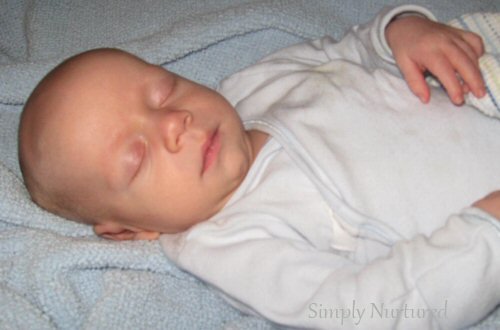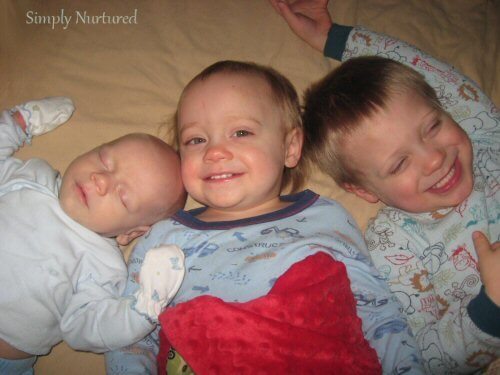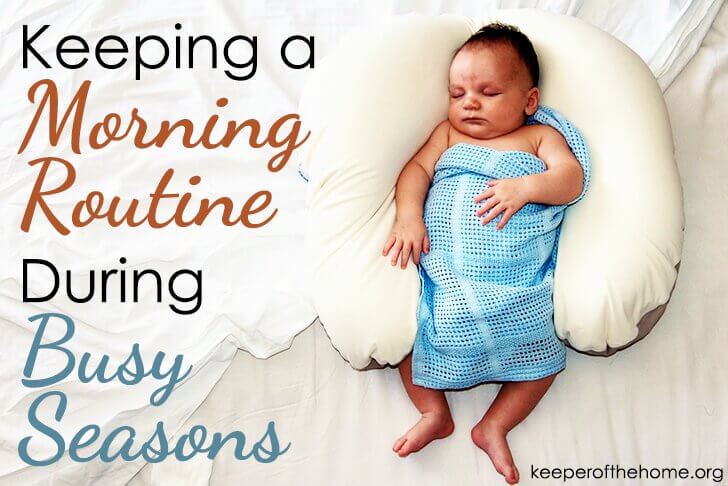Children’s Sleepwear: Avoiding Flame Retardant Chemicals

Written by Courtney, Contributing Writer
The warm summer evenings are turning into cool autumn nights. Your children’s closets are probably all set for fall weather, an organization project most of us like to do before the start of the new school year and long before the weather starts to cool down. Where we live, the weather is just getting chilly after a long and mostly warm month of September.
My children are turning in their short-sleeved pajamas for warm and cozy long-sleeved and one-piece sleepwear. I love snuggling up with my pajama-clad babies before bedtime, reading a good book or telling stories. And when it’s time to say goodnight, they look so comfy and peaceful tucked into bed with a warm blanket.

Toxins in Sleepwear
Our choice of sleepwear is an important one, considering the amount of time our children spend in slumber. Unfortunately, most pajamas are doused with chemical flame retardants that pose a major health risk to our little ones. It’s tempting to want to dress our babies in soft and fuzzy fleece pajamas, but we certainly don’t want the toxic chemicals that come with them.
These days, we must be cautious with what we expose our children to. Our world has turned from nature as a source of everything from food and medicine to clothing, and everything in between. Our man-made alternatives offer benefits in many situations, but there’s no doubt they come with a cost to the environment, and ultimately to our health.
What Can We Do About It?
It’s hard to remove all the toxins from our children’s environment, but choosing safe sleepwear is one easy step we can take to reduce their exposure.
Brominated flame retardant chemicals are added to sleepwear primarily due to the combustible nature of the synthetic fabrics most pajamas are made of. The majority of children’s pajamas are polyester, which is most often made from petroleum. The flame resistance is an extra step needed to counteract the flammable nature of these man-made fabrics, but this additional manufacturing process only “fixes” one bad idea with another.
Many mothers are alarmed at this dangerous manufacturing practice that puts our children in harm’s way during what should be the safest part of their day. Two common solutions to this problem are to wash the chemicals out of the clothing by doing the opposite of what the “to retain flame resistance” laundering instructions say and to push for a regulatory ban of these chemicals in children’s sleepwear altogether.
Both of these attempts to avoid these chemicals are faulty. The solution to toxic flame retardants is not found in laundering or lobbying. The solution is simply to purchase sleepwear made of natural fibers.
Washing out the flame retardants through using soap instead of detergent and running them through multiple cycles in an attempt to remove the chemicals is a bad idea for several reasons. Pushing for regulations to remove these chemicals altogether leads to the same problems.
- Some fabrics are made from fibers in which flame retardants have been chemically bonded. Requirements governing the use of flame retardants would likely not apply to fabric in which the chemicals have been bonded to the fibers before being made into fabric. And while laundering may remove flame retardants added to fabrics, it will not remove flame retardant chemicals that are chemically bonded to the fibers.
- Flame retardants are added to fabrics that are highly combustible, so taking away that protection, as dangerous as it is, poses a fire hazard in the event your child comes across something that could ignite, such as a candle or fireplace. Also, in the event of a house fire, these fabrics will ignite much more quickly and from further distances, reducing the amount of time you have to safely exit the home.
- If it is possible to completely remove the fire resistant chemicals, your child is still sleeping in a synthetic fabric, often that which was derived from petroleum. While some man-made fabrics are much safer than others, it’s still a good idea to stick with natural fibers.

What to Consider When Shopping for Pajamas
Shopping for pajamas can be complicated due to the fire resistance requirements and the clever ways around them. The fact that the majority of children’s sleepwear is made of synthetic fabrics makes our selections even more limited! My mom buys pajamas for each of my children every winter. My children look forward to this tradition and are excited to slip into them on Christmas Eve.
However, shopping for them drives my mom crazy. Because most pajamas are fuzzy polyester and labeling can be confusing at times, she’ll sometimes call me with questions about what to avoid and what is safe. These are a few shopping tips I’ve learned over the years:
1. Check the label for fabric composition. Opt for natural fabrics like cotton or wool and avoid synthetics such as polyester and nylon. ( Most cotton is free of flame retardant chemicals, but some cotton pajamas are treated.)
2. Always avoid sleepwear labeled: “To retain fame resistance” or Flame resistant fabric”
3. Look these labels instead:
“For child’s safety, garment should fit snugly. This garment is not flame resistant. Loose fitting garment is more likely to catch fire.” or simply “Wear snug-fitting, not flame resistant” This is the gold-standard in pajama shopping. This indicates that the fabric is not inherently flame-resistant and has not been chemically treated. It is a good idea to follow the “snug-fitting rule” since loose fitting clothing captures air between the fabric and the child and ignites much easier when exposed to a flame. This also reduces the risk of suffocation in younger babies.
“Not intended for sleepwear” This seems to be common with cotton/poly blend thermal underwear and loose fitting flannel bottoms. My children sometimes where these for pajamas and I’m okay with the small amount of polyester, probably used for its wicking ability.
4. Sleepwear for newborns and babies up to 9 months don’t follow the same rules. Sleepwear for babies under 9 months are not necessarily required to be flame resistant or to carry any labeling. Sleepwear for babies may still contain fabric made of chemically-treated fibers, so avoid synthetic fabrics altogether.
My favorite sleepwear for infants is simply a cotton tee or side snap shirt with a wool diaper cover over cloth. Swaddling a baby dressed simply like this makes for restful sleep and easy diaper changes…no unzipping/unsnapping and pulling legs in and out of pants or one piece outfits!
5. When purchasing fabric to make your own sleepwear, choose natural fabrics and be prudent about examining the label for any mention of flame resistance or chemical treatment. Often, 100% flannels, especially those with baby/toddler prints, will carry the warning “Not intended for sleepwear”. Flannel is more loose-fitting than other types of cotton fabrics, so the warning must be present to indicate that it doesn’t meet requirements for sleepwear. I think flannel is a fine option, particularly for older children.
I wouldn’t be opposed to using a plush or fuzzy synthetic when making pajamas for older children, as long as it isn’t inherently flame resistant (bonded chemicals) or treated with flame retardants, but I do try to limit the use of man-made fabrics in clothing and blankets and I always choose natural fabrics for babies.
If you’re interested in finding out more about the specific requirements for children’s sleepwear, you can most likely find your country’s requirements online. The U.S. Consumer Product Safety Commission’s regulations are found here.
This week at my blog, I will be discussing some of the other ways to reduce our children’s exposure to flame retardant chemicals, which are found in mattresses and bedding, car seats and other baby gear, and household furnishings.






The pesticides used in conventional cotton and the heavy metals used in clothing dye are pretty nasty as well.
@emily, Yes, you’re right! It’s always a good idea to buy organic to avoid both of these. There are also issues with things like iron-on decorations and sometimes even lead in snaps. I debated whether or not I should address all of these, but there are so many things to consider.
Hannah Anderson has organic cotton PJ’s for the whole family. I have always had to pay attention to fabrics, not only for the reasons you have mentioned, but also because of sensitivities in my family. I recently learned that a new dye made from peanut shells(I think it’s the shells) is about to start being used. This is really bad news for a mom of a peanut/tree nut allergic child. Especially since they do not have to tell what is in fabric.
@Linda, I have not heard of this dye with peanut/peanut shells in it! Wow, I’m really surprised that could pass regulation…okay, maybe not that surprised. Regulations don’t exactly protect us, do they? 🙂 But really, that could harm a lot of people since only a small amount of residue can cause a fatal reaction.
@Linda, My son has a possible peanut allergy (doctors haven’t confirmed) and I had heard that there is a specific protein in the peanut that is what people are usually allergic to. Possibly the protein is not present in the shells? Something to look into maybe.
What about organic PJ’s or bamboo ones? I have my daughter in bamboo pj’s now. With colder weather coming, I need to find something safe for her to sleep in. Thanks for this post!
@Suzann, I’m not too familiar with bamboo for clothing. What I do know is from reading about its characteristics and benefits in diapers and I’m very impressed. From what I understand, it’s safe and mostly free of chemicals and also very sustainable.
@Courtney,
Sustainable yes, but as a fibre bamboo is generally labelled as rayon or viscose, meaning that is undergoes chemical treatments…eek! Just think about, unlike cotton or hemp, bamboo is hard like a tree. In order to turn into a fabric, lots of chemicals have to be used. Unless you can find an organic bamboo (which are hard to find, but would mean that a person broke down the bamboo as opposed to a machine), I would not consider it to be along the lines of a natural fibre.
We’re about to have our first child so we’ve been buying and registering for clothes. We love wool so we’re using that when baby needs to be especially warm (we found some nice plain wool garments at Nova Naturals) and also plan to co-sleep which will help keep kiddo warm. It helps that we live (for the moment) in coastal Texas where it normally doesn’t get that cold. I don’t buy synthetics in general and always make sure the cotton says “not for sleepwear”. Insulating our attic this winter will help too!
@annie, You’re all set! I wish I would have known what I know now with my first child 13 years ago. I was clueless then and exposed my first two children to a lot of nasty junk. You are off to a great start preparing for your first. I LOVE wool. And you’ll find that it’s good for warmer and cooler weather alike. It keeps you toasty warm in the winter and doesn’t overheat in the summer! Co-sleeping is wonderful for so many reasons, and like you said, it will keep baby warm (but they won’t get too warm as they will adjust to your body temp).
Love this post! I just wanted to add that BabyLegs leg warmers (especially their organic cotton line) are another great option for clothing infants and toddlers! They are super handy for babes with fluffy cloth covered bums 😉 not to mention, they make middle-of-the-night diaper changes a breeze for mom, while still keeping the baby’s legs warm!
@Heather, Thank you. 🙂 And yes, Baby Legs! Great reminder! Those are wonderful for keeping baby warm and make for very easy diaper changes. They’re super easy to make from women’s organic socks, too.
@Heather, We used wool baby legs to help keep some warmth + easy diaper access, too. Loved it.
Great article! I am often asked why the nightgowns I make are not flame retardant. I often give my customers many of the above facts. I think from now on I will point them to your post.
@Margaret, Thank you! It’s funny how when something is regulated like this that people just learn to trust in the requirements without even understanding why. And the need for flame retardant chemicals is primarily for the dangers of coming across an open flame, such as a fireplace or candle, which is why requirements are only for children aged 9 months to 14, ones who would be walking and getting into things. Yes, synthetics will ignite more quickly in a fire, but in all reality, smoke kills before flames do, so if flames are present, the chances of surviving a fire are not good regardless of what you’re wearing. I know, sounds grim. I just wished more parents understood the long-term health effects of these chemicals instead of being frightened into thinking they’re necessary due to words like “not flame resistant” that might make some think it needs to be. I’m going to check out your blog and nightgowns!
I have always used/preferred cotton or wool for my boys, for the reasons mentioned above. But another reason is they are hot boxes and prone to heat rash if their little bodies cannot breath through synthetic fabrics easily. Thanks for the post though, I needed the reminder.
@Rita, Yes, that’s another great reason. I don’t buy the synthetics, but when I get them as gifts my children will wear them some and it’s amazing how overheated they get in them! The one thing I will buy is the cotton thermal underwear (that sometimes has a little poly in it) for under winterwear and things like that, and they sometimes wear them as PJs at night, but they don’t overheat in those. It’s those fuzzy fleece style that get SO HOT!
I just bought some flannell & a pattern to make my daughter her first night gown – I’m super excited! But I had to laugh when I noticed the pattern that is CLEARLY for pajamas has the label “Not intended for sleepwear”. I asked myself “then what exactly is it intended for?”
That is funny!
@Julie Harding, Haha, that’s our wonderful rules and regulations for you. Making your own is a great way to control what they’re made of! And nightgowns are so much easier than pants. I have 4 boys and 1 girl and I’ve noticed over the years that I’ve made a lot more clothes for my daughter than my boys combined since dresses and skirts are so easy. 🙂
I purchase 100% cotton fabric and make sleep shorts for my 3 sons. They wear old worn-out, washed 100’s of times, holey t-shirts on top. Each pair of shorts costs $2-4, depending on fabric choice and can last for 1-3 years and often passed down to others.
@Kathleen K, Those old, worn out shirts are the best, aren’t they? And making your own PJ bottons is certainly cheaper, isn’t it?!
I have never understood the need for flame resistant clothing. They say that it ist o protect from cooking accidents, but how many children cook breakfast over an open flame? And in house fires, smoke inhalation kills long before flames do. Plus, synthetics melt into the skin causing even more damage.
@Elnora, I just responded to a previous post pointing out some of the things you mentioned. This is so true. And about synthetics and how they melt/go up in flame, if you understand how they’re made to begin with, it’s easy to understand why! Before I followed the call to be home with my children, I was in college for 7 years, jumping from one major to another (no degree, by the way, just lots of knowledge and loans), but I took fabric science classes at one point, which made me want to stop wearing synthetics altogether!
I don’t buy all organic clothing (I’d love to but can’t fit it in the budget) but I am really picky about sleepwear for this reason. Hanna Anderson is great and last years patterns can be found for a reasonable price at costco and are so well made that I know they will last several kids. Wal-mart also has a brand of kids pajamas that are organic cotton and snug and are only $5 a set. They don’t have the longevity H.A. does but for that price I can buy a new set for each kid without feeling like I’m throwing money out the window.
@Mackenzie, I’ve heard of Hanna Anderson, but I’ve never bought anything. I will check that out. Thanks! I have seen those $5 sets at Walmart and have bought those before.
I’ve tried to follow similar rules when getting pyjamas. However as far as other items go, like furniture, matresses etc, its just something we personally cannot do anything about. I try to operate on the rule that I do what I can within my budget and sanity and trust that is all I can do. I think making many of the changes my family has made has already reduced the chemical load on our bodies a lot and therefore I simply do what I can do.
Its funny though that for me, in Canada, I have found the pyjama issue confusing since many articles are NOT labled as being flame resistant or not. They just say the fabric content and washing instructions, which say nothing about “to retain flame resistance”. I have seen this on items second hand that I think come from the states, but I have not seen this often in Canada at all. Myabe its just me, not sure.
@Nola, Interesting. I wonder if that means they aren’t required to be fire resistant or if they aren’t required to label it. I also agree that there are so many things to worry about and we’ll drive ourselves insane if we worry about everything, but some things are easier than others to avoid and, like you said, sleepwear is one of them. We can also buy safer bedding and mattresses, but there are so many things in the home, like carpet and insulation, that we sometimes can’t control. Every little bit helps.
@Nola, No, it’s not just you. I haven’t noticed the labelling as much in Canada, either. Now, I’m not sure whether that means the chemicals are being used less, whether the labelling laws aren’t as strict, or if I just shop used too often so I’m not really aware of how new things are labelled (highly possible!).
@Stephanie @ Keeper of the Home, So what do you do then Stephanie, being in Canada?
Sometimes I just feel so frustrated that there are SO MANY issues we have to think about or make a decision on. Its kind of overwhelming at times. Then the things I can’t do anything about do worry me. There has to be a balance…like I would go broke replacing our mattresses and the carpeting we do have etc etc. and even if I had that money, there are other uses for it (like supporting those people who have way less than I do) but its very complicated. Even if I myself make choices, others around me don’t…so I am exposed to things and my children are exposed through that sometimes eg. gifts, being out in public, friend’s, etc. even simple things like having a plumber come over the air after he left made me sick from whatever cologne/fabric softener etc. he was wearing! Sometimes I am honestly just thankful that at least this isn’t all there is to life and that we do have hope in eternity without these problems. Otherwise I think I would be depressed.
@Nola, I agree, it can get overwhelming sometimes. We haven’t been able to do things like mattresses or furniture, etc. and we live in rentals so we have absolutely no say over carpets or anything like that, either. I just have to try not to think about those things, submit them to the Lord, and realize that I can’t do everything or control everything. Sometimes it’s hard and I feel frustrated with what I can’t do, but I think it really does give me hope that this life is all that there is, and one day none of this will matter. I look forward to that day. 🙂
@Nola, (and Stephanie) Philipians 4:6 comes to mind. I don’t think we should worry about what we can’t control. There’s a big difference between being wise stewards of our family’s health and obsessing over what we’re exposed to (which is SO much!) It is so hard not to worry about all the stuff we’re exposed to on a daily basis! I try to focus on making wise decisions about how we care for our little ones, what we buy, what we inject into them (or not), what we feed them, etc., lifting up their health and safety to the Lord in prayer.
Amen, Sister!! The blood of Jesus has power over everything that is named, and that includes jammies. 🙂
I love this. I hadn’t even thought about pajamas. I am excited to read about getting rid of more flammable and toxic items in my home. It’s no wonder that SIDS is so prevalent with the abundance of chemicals that our children are breathing in each evening. Any ideas on binkies???
@Stephanie, You’ll be surprised at how many things contain flame retardants! So don’t get too discouraged when you start reading more about it…remember there’s only so much we can do. This is what I told myself when I learned that flame retardants are added to everything from cell phones to car seats. TVs, stereos, couches, you name it, most things synthetic since synthetic materials are so flammable.
By binkies, do you mean pacifiers? That’s what I call binkies, but I’ve heard people use different terms for those and other baby items. On binkies, it’s the phlalates and things like that you have to worry about. Most are BPA free now. My babies never really took to binkies, so I don’t know that much (same with bottles where the nipple would be the same issue), but I’m curious myself because I’m looking into a few brands and am considering adding them to my store.
@Stephanie, We used Natursutten pacifiers made from 100% natural rubber from the rubber plant. They are expensive and do need to be replaced often, but I felt fairly good about them going in my infant daughter’s mouth. At about the third replacement after having a hard time getting a hold of one, I switched to a BPA-free, silicone nipple paci from the store. I know there are other things besides BPA in plastics (especially when they take BPA out), but it was the best I could do. My first daughter is STILL addicted to the things and my new baby won’t take it for anything! So, It will be nice to be paci free for a while!
Yes, so much to think about here! I’ve always chosen natural fibers over artificial, but recently we’ve gotten away from worrying so much – favoring cheap or free over “safe.” Lots of things to take in consideration to be good stewards of our families. I know though that we could sacrifice having as many outfits as we have for the sake of owning better quality materials.
Also have to throw in that our detergent matters. We potentially expose our little ones to all kinds of chemicals while trying to “clean” their clothing if we’re not careful!
@Anjanette, Yes, detergent matters just as much! I’m pretty picky about PJs, but it is hard to resist free, as in gifts and hand-me-downs! I used to be lenient with hand-me-down PJs, thinking the flame retardants must be washed out, but now I’m pretty strict with just passing on those. And while I prefer organic cotton PJs, I’m okay with conventional, too, since the budget doesn’t always allow. I know it’s important to purchase organic for our buying power and to keep those nasty chemicals out of our air and water, though. I’m also curious if the pesticide residues come out with washing…. Oh, and we have to think about the formaldehyde and things like that that’s added to new clothing just to make it look fresh and new in the store. 🙁 I prefer to buy second hand, so hopefully that junk washes out, too!
Courtney, do you know if this is an issue with baby blankets also? My son has two of the fuzzy-type blankets that he sleeps with, and I have never given much thought to it. I’ve known about the flame-retardant chemicals in pajamas for a while now and do my best to avoid them, but I’ve never looked into the blankets. Would love your advice on this!
@Mindy @ The Purposed Heart, I have mixed feelings about blankets. From what I understand, they don’t have the same regulations requiring them to be flame retardant, but some are. (However, your standard crib bedding is flame resistant!) My worry would be with the blankets that are flame resistant because chemicals were added to the fibers, meaning they may not say they are FR. Fuzzy plush microfiber blankies are hard to resist, though, aren’t they? We have some, but we prefer natural fibers and always stick with natural fabrics for our babies, especially at bedtime. We make most baby blankets on our own and try to be careful about fabric selection.
This is a good thing to start thinking about. I’ll be having my third in about 2 months and I am FINALLY a stay-home mom this time so I can do things that I want to, like cloth diaper instead of disposables, etc. Sleepwear is honestly not something that even crossed my mind. Although I will say that if I take a mental inventory, besides the inevitable fleece PJs most of my kids sleepwear is either cotton or they just sleep in shorts and a t-shirt. I quit with the fleece PJs when my kids are potty-trained because that way they could use the bathroom at night without help, but I never thought about it for the baby. One good thing I will say is that I am an avid swaddler – both my girls were swaddled for sleeping until about 6 months old. In fact, I even have special cotton flannel blankets I made for this purpose.
In any case, thanks for this – I’ve heard people talking about avoiding the flame retardant fabrics but hadn’t really given it much thought. There’s just so much toxic stuff in our everyday lives that it is just way too easy to get overwhelmed and give up on even trying,
@Bethany, Oh, I know! There’s so much, it can be hard at times to discern what is wise to consider and what is needless worry and beyond our control. I do think PJ’s are something we should think about, and choosing safe sleepwear is pretty easy once you get the hang of it.
I’m an avid swaddler, too! It makes for a warm, cozy baby and a restful sleep. 🙂 I’m glad you’re considering cloth. It can be overwhelming at first, given all the options today, but you’ll quickly learn about the different options and what type of diaper works best for your family. I will be adding more diapers to my store in the coming months. I’ve tried TOO many diapers, so I have a lot of hands on experience and feel I’m choosing the best brands. 🙂
I learned about this issue when I was pregnant with baby #1. I STRICTLY returned every fleece outfit or pajama that she received. I have been pretty diligent ever since in avoiding as much of the synthetic stuff as I can in her clothes, sleepwear, bed coverings, etc. It’s impossible to keep ALL of it away, but even with most stuff coming from the thrift store, we’ve been able to get a lot of 100% cotton stuff.
I too am thankful to find Hanna Andersen organic sleepwear at Costco. It is cute, form fitting, soft, comfortable, warm, and organic! Also, Costco has a line of organic sleepwear too. I really want to make some flannel nightgowns for my daughter. Maybe I’ll get industrious and make matching ones for my two girls and maybe even a doll or maybe even mama . . . . Hmm, I’ll have to think about that. I do think to help our 2.5 year old daughter night potty train, we are going to have to make a few nightgowns!
@Andrea S, Our buying power is going to be the strongest push to get these flame retardants out of our PJs! Good job! 🙂 And I have got to check out this Hanna Anderson. I’ve heard of it, but I haven’t seen it. We don’t have a Costco nearby and I don’t even think I’ve ever been to one.
I’m so glad you wrote about this topic, Courtney. It’s one that I just don’t know enough about, and so once again, I am delighted to have contributing writers with a broad and varied knowledge base! It’s definitely making me think more about what my kids will be wearing this winter. I buy our kids clothing almost entirely used, and sometimes that does include fleece because it just happens to be the right size and the right price. I think I’m going to try to avoid fleece this winter and lean more towards regular cotton, and then organics if we can find some that are affordable. For the new baby, I’m going to work towards entirely organic and natural fibers.
@Stephanie @ Keeper of the Home, Thank you, Stephanie! I’m really curious about Canada’s requirements now. I was going to check into it when writing the post, since you and many of your readers are in Canada, but I didn’t and should have. I would be concerned that if there are no labeling laws, it could still be in the fibers.
I like your plan for your the new baby. It’s too bad organic cotton is so expensive. In reality, it’s conventional that’s so cheap and we’re used to it… but it just costs so much more! It’s usually beyond our budget.
Making our own has been a good solution for us here. I use cotton fabrics for nightgowns and cotton knit for sleeping caps and leggings (my husband is *quite* bald and a sleeping cap is a necessity year-round.) My little girls prefer to swipe undershirts from our son, and wear those as a nightgown; my oldest daughter swipes undershirts from my husband. 🙂
Homemade nightgowns don’t have to be complex. We’ve even kludged some together by adding a woven cloth skirt to a knit tank undershirt.
For my babies, I like cotton knit gowns, but we also have “woolies”–gorgeous handknit wool blankets my mother has made for each baby. They get used year round. A light cotton gown, plus being swaddled in a woolie, makes for a happy, cozy baby!
@Liz C, Oh yes, your woolies sound so cozy! And great ideas for making PJs our of shirts/skirts! Resourceful. 🙂
If some chemicals are bonded to a fabric, and it doesn’t come out with washing, wouldn’t it be a very slim chance that it is going to come off onto a child?
@Jessica Y, I had the exact same thought.
@Jessica Y, I don’t think any chemicals, whether it be flame retardants doused on fabrics, pesticides in cotton, wrinkle-free chemicals, etc… actually rub off on children. I’ve never heard of that, but maybe they do. The health risk is breathing in the fumes and absorbing them through the skin. It’s the contact with the fabric, not the transfer of the chemicals.
What a coincidence! I just read another blog post about flame retardants and how bad they are for all of us, especially little ones.
http://oecotextiles.wordpress.com/2010/07/21/what-are-pbdes-and-why-should-i-be-concerned/
I do have some cotton pjs, but had not specifically avoided the flame retardant kind. Thanks for bringing this to my attention.
@Al Dente, I just glanced at this article. I’m glad more people are spreading awareness and concern!
For my 2 year old daughter, I buy boys undershirts (size 4T or so) and use them as nightgowns. They are nice and cool during our hot Florida summers. I like to decorate them with appliques or fabric paint to make them fun and personalized instead of boring white PJs. This is a really cheap option too, as a pack of 5 undershirts cost me about $8.
@Greta, That is cheap! I like your idea, decorating them, too!
I remember wearing big t-shirts as a child that were like nightgowns. The older, the softer and better they were! My parents actually kept some of those old t-shirt/PJs and they are even softer decades later! My children wear them from time to time.
What about polyester pajamas? Are they bad for some reason? I read on Carter’s website that their polyester pajamas are inherently flame resistant (different than flame retardant) and are not treated with chemicals. I know polyester is synthetic so maybe there’s something bad about it that I don’t know? I really need a warm pajama option as my son is too wiggly to stay under a blanket. Thanks for this post!
Actually, cotton is more flammable than polyester and therefore more likely to be treated. In the 1970’s treating pj’s with flame retardants was common but it didn’t last long because they were found to be toxic. Today, it is estimated that less than 1% of all baby pajamas are actually treated to be marketed as flame resistant, but there is still interest in the procedure because some parents feel it is the only way to keep their baby safe. To answer the need, several major children’s clothing lines have begun selling 100% cotton pajamas treated with a flame retardant chemical called PROBAN. Clothing that has been treated must be labelled (at least in Canada)
What a great post! I found it while searching for fabric for children’s sleepwear. I have never understood flame retardant/restitant sleepwear so have just avoided it altogether. My husband and I are cotton only people, it has just always been our preference and we didn’t change that with the kids. Planning to make matching pj sets for my son and daughter, guess now I have my answer…. I’ll just get a 100% cotton print I like and start creating!
“Unfortunately, most pajamas are doused with chemical flame retardants that pose a major health risk to our little ones.”
Sorry hun, this just isn’t true. They stopped this practice a long time ago. I have spoken with both Carter’s and Gerber, and they both say that none of their sleepwear is treated with chemicals. They say that polyester is inherently flame resistant (not retardant).
I’m going with 100% cotton just because it’s breathable and won’t cause heat rash though so I definitely agree that natural is best, but I’m afraid the inaccurate information in this article might cause some mothers unnecessary stress thinking they have endangered their children.
Is the information quoted inaccurate? Yes and no:
All pajamas are *not* necessarily doused with flame retardants.
*However,* the flame-resistant ones that are not “doused” with them, have them *woven into the fabric.* Therefore, Carter’s and Gerber are allowed to state that they are not “chemically treated.” I have read that this kind of treatment cannot be washed out, and either way, the companies are to test their products’ flame-resistance after 50 washings. You can look up this info online.
So yes, go for “snug-fitting” non flame resistant p.j.’s
I recently received an e-mail from a relative that contained info from a pediatric nurse regarding flame resistant sleepware. Research has been done but not yet published that there is a chemical used in the process that causes
thyroid cancer. Another reason to avoid items treated in this way.
This article discourages me. As a new mom I had never heard about this and have not looked at tags of her pajamas or blankets. Nothing has tags on it to be returned and we just don’t have the money to buy all new pajamas. What alternative do you suggest for those moms who were unaware of these chemicals? Because now I just feel awful that my infant may be wearing unsafe sleepwear but it is not feasible for me to get rid of all her fleece pjs and blankets. We live in buffalo where it is cold for much of the year! What is your suggestion for someone in my scenario?!
I’ve been wondering for a long time why children’s sleepwear needs to be snug fitting or flame retardant compared to regular clothing. Is there proof that children are more likely to catch fire in their sleep than during the day? I don’t get it. If these regulations are as antiquated as the need for Daylight Savings Time, I’m baffled as to why the practices continue.
pollyester may be inheritly flame resistant and not necessarily treated with flame retardant but the “fabric” contains pertrolium.. So either way its not a good fabric to wear :/
As a mom, I wanted to avoid flame retardants and keep my sons warm enough in a blanket-free crib. I created my own sleepwear line, Snug Organics, when I couldn’t find what I was looking for. Our sleepers are made of 100% organic cotton sherpa, which has a similar feel to polyester fleece, but is a natural breathable fiber. Check us out: http://www.snugorganics.com.
Thank you for your article – I am a 55 year old mom soon to be grandma who is having issues with flame retardants. You might be interested to learn that even at my ripe older-ish age my skin gets weirdly dry and any open wounds (I have a pit mix dog who uses her paws too much so arm wounds are a part of my daily life) won’t heal and are weirdly inflamed when left uncovered and allowed direct exposure to my sofa (I threw it out a week ago) and had a remarkable noticeable improvement withen 24 hours. I truly believe that flame retardants are bad for everyone no matter the age, and I’m trying to remove them from my life I’m currently trying to read about fabrics and how to identify good from bad so your article was hugely helpful. I have three dogs and they sleep with blankets as well as I sleep with blankets 🙂 and I’m now on a mission to make every single thing that we sleep on safe. thanks for your information it’s been up till now the most informative thing I’ve read and today I am off to find all natural materials for sleeping on/in.
Thank you for this article! My 12 month old son recently started having skin issues and after eliminating all scents, dyes and perfumes in his skin care regimin we finally turned to prescription strength but it still didn’t help. Now after reading your article my suspicions that he was having an allergic reaction to his polyester fleece jammies is confirmed. Thank you so, so much!
In doing research about avoiding chemical flame retardants, I have read in multiple places that polyester is inherently flame resistant and therefore NOT treated with chemicals and that cotton often IS… I’m avoiding polyester and other synthetics to begin with because of other risks of these fabrics but I am getting confused and frustrated by the conflicting information out there. Can you clarify your information or point me to other more concrete sources that say what is what? thank you…